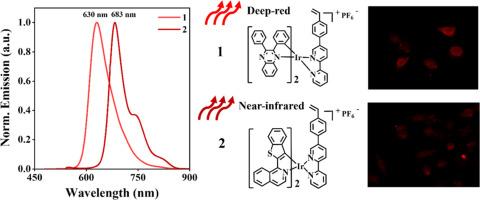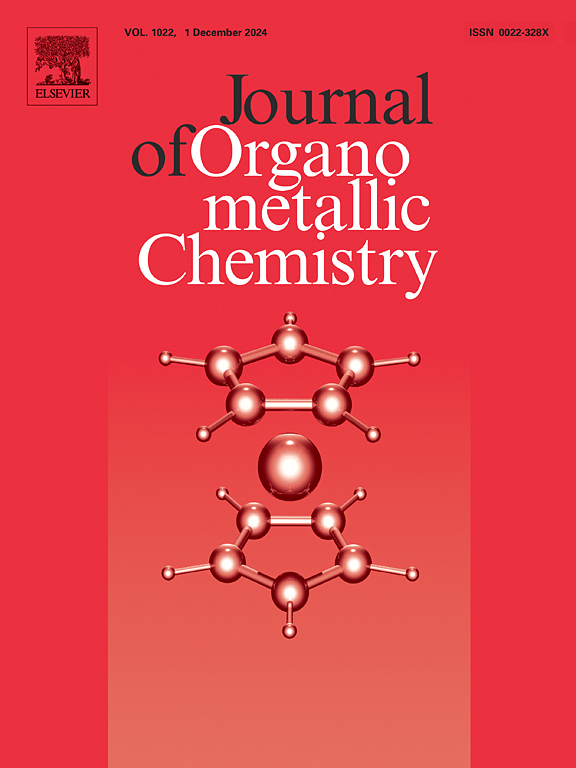Deep-red or near-infrared-emitting Iridium (III) complex as efficient phosphorescent dye for live cell imaging through staining in cytoplasm
IF 2.1
3区 化学
Q3 CHEMISTRY, INORGANIC & NUCLEAR
引用次数: 0
Abstract
Despite the bioimaging highly realized from Ir(III)-complexes with visible-light, the staining on organelles by NIR-emissive (NIR = near infrared) Ir(III)-complex species especially in cytoplasm was rarely reported. In this work, two new cationic iridium (III) complexes ({[Ir(C^N)2(N^N)]+ ·(PF6)−}; C^N = 2,3-diphenylquinoxaline (dpqx)− or 1-(benzo[b]-thiophen-2-yl)-isoquinoline (iqbt)−; N^N = 2-(pyridin-2-yl)-5-(4-vinylphenyl)pyridine (4vp-2,2′-bpy)), namely {[Ir(dpqx)2(4vp-2,2′-bpy)]+ ·(PF6)−} (1) and {[Ir(iqbt)2(4vp-2,2′-bpy)]+ ·(PF6)−} (2) with efficient deep-red ( = 630 nm, ΦPL = 0.19) and NIR-emissions ( = 683 nm, ΦPL = 0.16), are obtained, respectively. Moreover, beneficial from the excellent biocompatibility and low cytotoxicity, each of the two cationic iridium (III) complexes 1 and 2, enables to exclusively stain in the cytoplasm of live cells. This research might provide two ideal candidates in the design of high-efficiency deep-red or NIR emitting cationic iridium (III) complexes for specific bioimaging agents.

作为高效磷光染料的深红或近红外发光铱(III)复合物,可通过细胞质染色进行活细胞成像
尽管铱(III)络合物利用可见光实现了高度的生物成像,但近红外辐射(NIR = 近红外)铱(III)络合物对细胞器的染色,尤其是对细胞质的染色却鲜有报道。在这项工作中,两种新的阳离子铱(III)配合物({[Ir(C^N)2(N^N)]+ -(PF6)-};C^N = 2,3-二苯基喹喔啉(dpqx)- 或 1-(苯并[b]-噻吩-2-基)-异喹啉(iqbt)-;N^N = 2-(吡啶-2-基)-5-(4-乙烯基苯基)吡啶(4vp-2,2′-bpy)),即{[Ir(dpqx)2(4vp-2、(4vp-2,2′-bpy)]+-(PF6)-}(1)和{[Ir(iqbt)2(4vp-2,2′-bpy)]+-(PF6)-}(2),具有高效的深红色(λemMax = 630 nm, ΦPL = 0.19)和近红外发射(λemMax = 683 nm, ΦPL = 0.16)。此外,由于这两种阳离子铱(III)复合物 1 和 2 具有极佳的生物相容性和低细胞毒性,因此它们都能专门对活细胞的细胞质进行染色。这项研究可能会为设计用于特定生物成像剂的高效深红或近红外发射阳离子铱(III)复合物提供两种理想的候选物质。
本文章由计算机程序翻译,如有差异,请以英文原文为准。
求助全文
约1分钟内获得全文
求助全文
来源期刊

Journal of Organometallic Chemistry
化学-无机化学与核化学
CiteScore
4.40
自引率
8.70%
发文量
221
审稿时长
36 days
期刊介绍:
The Journal of Organometallic Chemistry targets original papers dealing with theoretical aspects, structural chemistry, synthesis, physical and chemical properties (including reaction mechanisms), and practical applications of organometallic compounds.
Organometallic compounds are defined as compounds that contain metal - carbon bonds. The term metal includes all alkali and alkaline earth metals, all transition metals and the lanthanides and actinides in the Periodic Table. Metalloids including the elements in Group 13 and the heavier members of the Groups 14 - 16 are also included. The term chemistry includes syntheses, characterizations and reaction chemistry of all such compounds. Research reports based on use of organometallic complexes in bioorganometallic chemistry, medicine, material sciences, homogeneous catalysis and energy conversion are also welcome.
The scope of the journal has been enlarged to encompass important research on organometallic complexes in bioorganometallic chemistry and material sciences, and of heavier main group elements in organometallic chemistry. The journal also publishes review articles, short communications and notes.
 求助内容:
求助内容: 应助结果提醒方式:
应助结果提醒方式:


